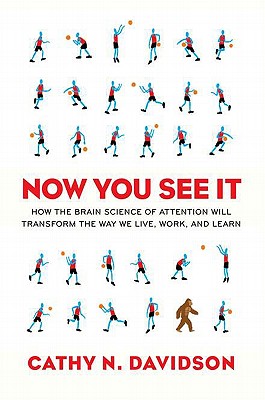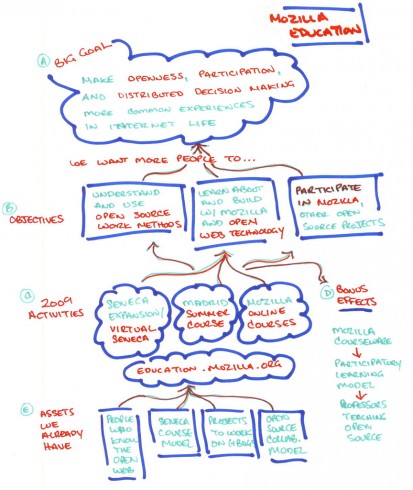
Cathy Davidson‘s Now You See It argues that the educational system in the US is failing to prepare graduates for the work they will be doing in the 21st century. While I found myself vigorously nodding at the general argument of the book, there were also some places I wished Davidson had developed in greater detail.
The best part of the book for me is the description of the roots of our standard educational approach going back to the early 20th century: Taylorism, the IQ, and standardized testing on a large scale. These approaches made sense when education’s focus was the creation of disciplined, managerial, bureaucratic middle-managers for hierarchical, command-and-control corporations.
Unfortunately, while the workforce is adapting to new realities of globalization, the digital revolution, and commons-based peer production, the educational system has not kept pace.
She’s definitely on to something, and I agree with much of her rant in both its aims and its general tenor. She’s also generally compelling when she talks about the variety of approaches they’ve taken at Duke (distributing iPods, how to crowdsource grading) and that she’s experienced as director of the HASTAC program (and as an all-around digital humanities evangelist).
The book’s a bit weaker, for me, when she tries to describe alternative educational approaches which embody the values and approach she wants to promote: collaboration through difference, game mechanics, and creative expression over standardized testing. They end up resonating as anecdotes but don’t provide a true alternative program which could be managed at any broad scale.
I also found the sections on what the modern workforce is like rang a bit hollow. It’s easy to critique Prof. Davidson as an academic – the old “Ivory Tower” versus “real world of work” contrast – but I think it’s fair to say that Davidson doesn’t reflect deep lived experience here in describing the “average” office worker, whatever that might mean.
If you have a job just about anywhere but Google, you are most likely working in a space designed for a mode of work that is disappearing. . . . We’ve just begun to think about the best ways to restructure the industrial labor values we inherited in order to maximize our productivity in the information age.
Maybe it’s just because I’ve spent the last 12+ years working in interactive agencies, on web projects, and with open source communities, but the descriptions Davidson offers of all the signposts of the new felt immediately familiar to me, as I suspect they would to anyone working in web strategy, design, and development. Global conference calls supplemented by a digital backchannel (irc / IM, over public networks or internal intranets) and web-based collaboration environments (maybe we don’t all use Second Life, but the specific technology isn’t really the point), working toward consensus and community-driven decision making over command and control – this is how everyone I know works!
Again, I don’t think this takes away from Davidson’s primary point about the organization of the educational system in relation to the way work actually happens – I just think the new mode of work is even more widespread than she suggests. It isn’t just the denizens of the Googleplex or Big Blue who are working in a collaborative, technology-embedded, continuous partial attention world. (It’s also not just agencies, based on what I’ve observed at clients).
The second place where I wanted more from Davidson was in what industry likes to call “the solutions space.” Other than reducing class sizes, and decreasing reliance on standardized tests (which drives the behavior of teaching to the test rather than the kind of critical thinking, research, and collaboration skills Davidson emphasizes), what path should educators (or parents) take?
Davidson gestures in the direction of solutions with a few specific cases of schools and a broad discussion of game mechanics (cue Jane McGonical). Would substituting boss challenges for end of grade (standardized) testing be both radically productive in improving education and sustainable at large scale? If every university starting giving students iPods (or perhaps now iPads) and eliminated letter grades, would that magically shift the conversation back to creativity and collaboration?
I was also concerned at Davidson’s fast and loose use of “crowdsourcing” and “open source” as though they were interchangeable or nearly interchangeable references to work done by large groups. (The simple fact that she’s talking about cooperative production and there isn’t a single mention of Yochai Benkler’s The Wealth of Networks or The Penguin and the Leviathan or, for that matter, the Public Library of Science, or Open Courseware). There’s one quick nod to Creative Commons but it’s dismissive: “it’s not always a simple matter in a collaborative endeavor to agree to ‘share alike'” (232).
Instead we get broad references to “open source” via Linux and Mozilla, and crowdsourcing via Wikipedia, but with no clear definition or explanation of how free software and open source communities came to be or organize themselves. There doesn’t really seem to be any recognition of the core freedoms open source is really about. She cites the Cathedral and the Bazaar, but never really explores why or how this mode of production compares to traditional software (which is very much still present and arguably even dominant in education). There doesn’t seem, for example, to be any concern about the involvement of companies like Apple and in driving educational initiatives. What does it mean to train students on a proprietary platform when free platforms are also available? What impact might the free software and free culture movements have on institutional education (elementary on through tertiary) if we took seriously their challenges to proprietary software and big corporate media?
(Starter Recommendations: Chris Kelty’s Two Bits: On the Cultural Significance of Free Software, Gabriella Coleman‘s research on the ethics of hackers and hacking.).

The last major gap I was surprised to see Davidson not explore further is alternative educational approaches. There’s no mention of homeschooling or diy education: increasingly used by significant segments of the population to opt-out of the institutional part of the educational system. Would she support this approach, as it is inline with adaptive learning and flexibility and anti-standardized testing, or would she bemoan the approach as it doesn’t provide enough collaboration? (Of course, home-schooled students could collaborate online with others, which might pretty closely mirror the life of the new IBM consultant – some have said IBM stands for “I’m By Myself”).
In the end, Now You See It is a compelling read if you’re interested in the failings of standardized testing, and exploring more creative, internet-era-appropriate methods of education. The challenge it raises to educators is a signal one: how are we checking our own institutional biases in favor of really exploring what students will need in the workforce, and how can we make school more like the new workplace?
As someone who’s argued that Lolcats belong on your corporate intranet, I’m sympathetic to Davidson’s desire to recuperate the reputations of internet “distractions” and recognize that it is ok that kids like video games and that students might spend part of their school day on thinking that is not immediately measured on a multiple-choice test. I just wish there was a more specific program of actions we could take to get there, as I want to play along.


Thanks for this excellent review. I hasten to mention that I teach Benkler et al, of course, and blog about open source and lots of other things almost every day both at http://www.hastac.org website that I organized with others in 2002. I also blog monthly at http://www.dmlcentral.com. I also consult for business, mostly those that are not in the situation you are but that are making the transition, slowly and often painfully, from old-style HR and management systems to new. So, then, why isn’t more of this in the book? Ah, the oldest excuse in the book: my editor made me do it. We cut hundreds of pages on the way to a final draft, there WILL be a sequel, my blog has lots about all of these topics and, yes, it would have been a better book with a lot of this left in. Neither William James nor Dali Lama made the final cut either and I always lecture about James, the first person in English to write a chapter on attention. (NB: I am forwarding this comment to my editor right now—-on the other hand, far fewer people would have read it if I’d won that debate and it had been a third again as long. He was totally right about that one.) No excuses. I agree with your critique! And have made it myself often, in other contexts. Thanks so much for your attention. Best wishes, Cathy Davidson
Thanks Cathy. Small world – your colleague Priscilla Wald, whom you thank in the book, was on my dissertation committee at the University of Washington back in 1998.
Looking forward to a sequel, and to hearing more from HASTAC.